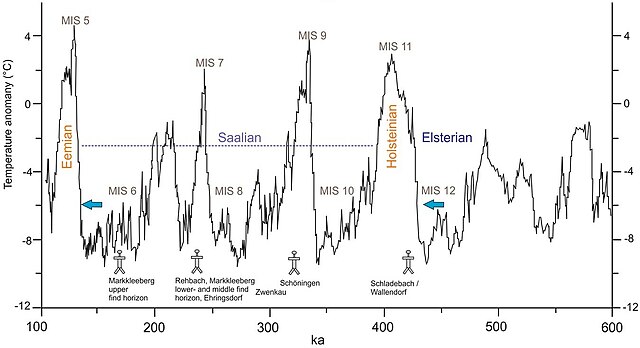The Last Interglacial, also known as the Eemian among other names was the interglacial period which began about 130,000 years ago at the end of the Penultimate Glacial Period and ended about 115,000 years ago at the beginning of the Last Glacial Period. It corresponds to Marine Isotope Stage 5e. It was the second-to-latest interglacial period of the current Ice Age, the most recent being the Holocene which extends to the present day. During the Last Interglacial, the proportion of CO2 in the atmosphere was about 280 parts per million. The Last Interglacial was one of the warmest periods of the last 800,000 years, with temperatures comparable to and at times warmer than the contemporary Holocene interglacial, with the maximum sea level being up to 6 to 9 metres higher than at present, with global ice volume likely also being smaller than the Holocene interglacial.
View of the Last Interglacial–aged coastal terraces of Niebla near Valdivia, Chile.
Collage of temperate forest environments in Europe during the Eemian, with animals including fallow deer, aurochs, Merck's rhinoceros and straight-tusked elephants.
Last Interglacial erosion surface in a fossil coral reef on Great Inagua, The Bahamas. Foreground shows corals truncated by erosion; behind the geologist is a post-erosion coral pillar which grew on the surface after sea level rose again.
Bittium reticulatum Picture from Pieter Harting (1886) assigned by him as 'Index fossil' for the Last Interglacial.
Penultimate Glacial Period
The Penultimate Glacial Period (PGP) is the glacial period that occurred before the Last Glacial Period. The penultimate glacial period is officially unnamed just like the Last Glacial Period. The PGP lasted from ~194,000 years ago, to ~135,000 years ago, and was succeed by the Last Interglacial. The PGP also occurred during Marine Isotope Stage 6 (MIS6). At the glacial ages’ height, it is known to be the most extensive expansion of glaciers in the last 400,000 years over Eurasia, and could be the second or third coolest glacial period over the last 1,000,000 years, as shown by ice cores. Due to this, the global sea level dropped to between 92 and 150 metres below modern-day global mean sea level. The penultimate glacial period expanded ice sheets and shifted temperature zones worldwide, which had a variety of effects on the world's environment, and the organisms that lived in it. At its height, the penultimate glacial period was a more severe glaciation than the Last Glacial Maximum. The PGP covers the last period of the Saalian glaciation in Europe, called the Wolstonian Stage in Britain, and is equivalent to the Illinoian in North America.

Diagram of glacial cycles, with the Penultimate Glacial Period labelled as MIS 6.





